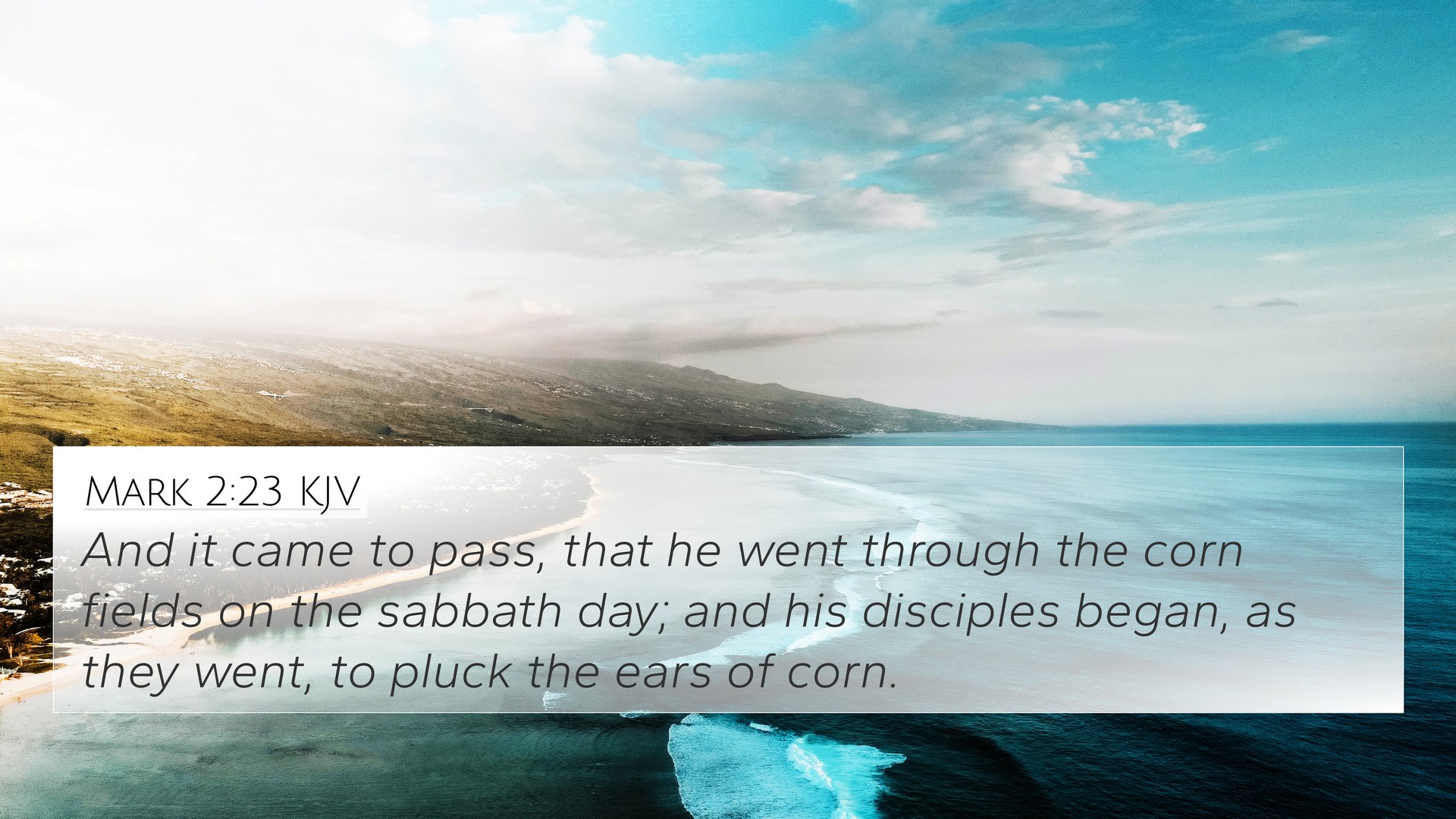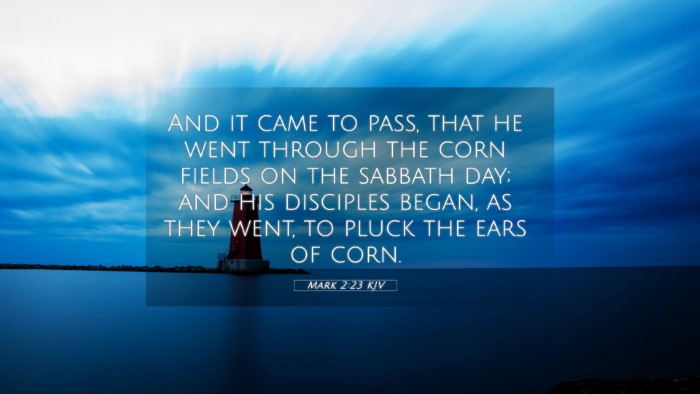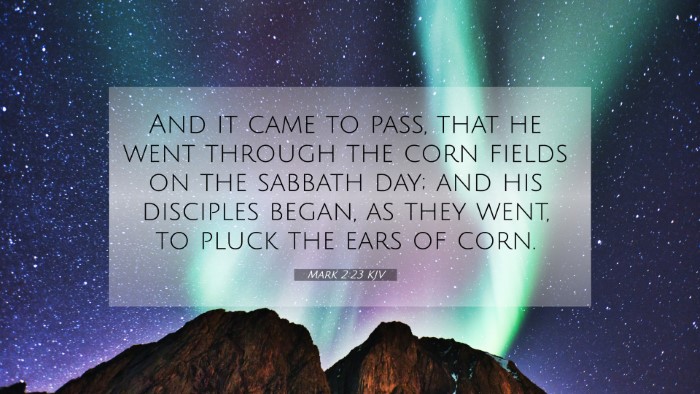Old Testament
Genesis Exodus Leviticus Numbers Deuteronomy Joshua Judges Ruth 1 Samuel 2 Samuel 1 Kings 2 Kings 1 Chronicles 2 Chronicles Ezra Nehemiah Esther Job Psalms Proverbs Ecclesiastes Song of Solomon Isaiah Jeremiah Lamentations Ezekiel Daniel Hosea Joel Amos Obadiah Jonah Micah Nahum Habakkuk Zephaniah Haggai Zechariah MalachiMark 2:23 Similar Verses
Mark 2:23 Cross References
And it came to pass, that he went through the corn fields on the sabbath day; and his disciples began, as they went, to pluck the ears of corn.
Uncover the Rich Themes and Topics of This Bible Verse
Listed below are the Bible themes associated with Mark 2:23. We invite you to explore each theme to gain deeper insights into the Scriptures.
Mark 2:23 Cross Reference Verses
This section features a detailed cross-reference designed to enrich your understanding of the Scriptures. Below, you will find carefully selected verses that echo the themes and teachings related to Mark 2:23 KJV. Click on any image to explore detailed analyses of related Bible verses and uncover deeper theological insights.
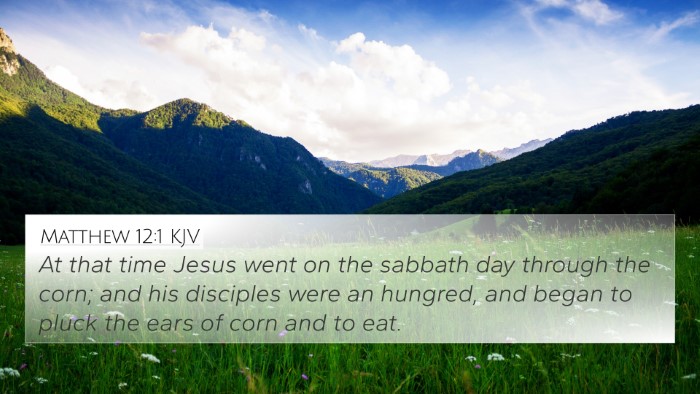
Matthew 12:1 (KJV) »
At that time Jesus went on the sabbath day through the corn; and his disciples were an hungred, and began to pluck the ears of corn and to eat.
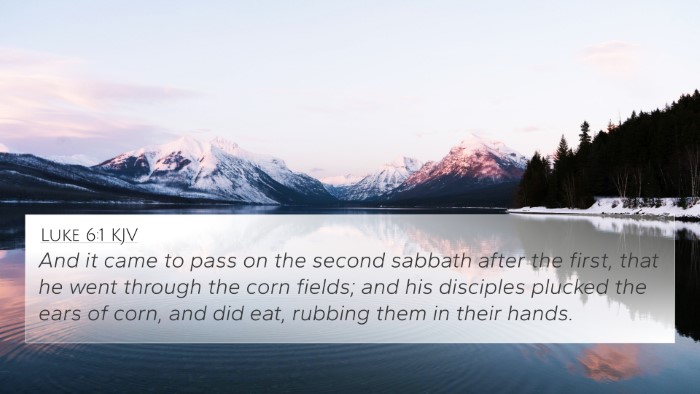
Luke 6:1 (KJV) »
And it came to pass on the second sabbath after the first, that he went through the corn fields; and his disciples plucked the ears of corn, and did eat, rubbing them in their hands.
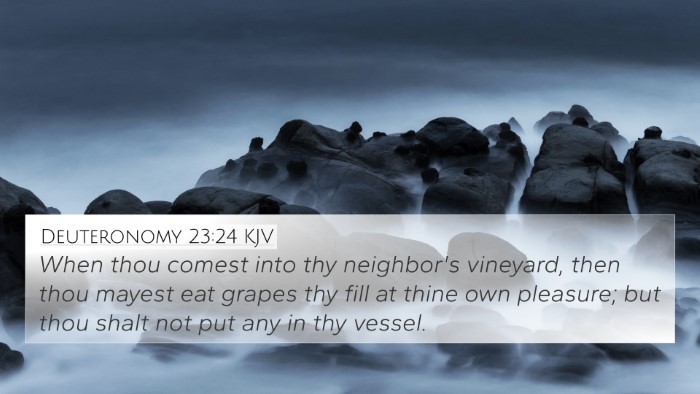
Deuteronomy 23:24 (KJV) »
When thou comest into thy neighbor's vineyard, then thou mayest eat grapes thy fill at thine own pleasure; but thou shalt not put any in thy vessel.
Mark 2:23 Verse Analysis and Similar Verses
Understanding Mark 2:23
Mark 2:23 captures a significant event in the life of Jesus, highlighting His approach to the Sabbath and the traditions surrounding it. This verse details the actions of Jesus' disciples as they plucked heads of grain on the Sabbath, sparking controversy with the Pharisees.
Verse Context
In this chapter, Jesus is confronted by religious leaders who are strict about the observance of the Sabbath. The verse exemplifies a moment when Jesus challenges the rigid interpretations of the law.
Commentary Insights
- Matthew Henry: He emphasizes that the Sabbath was made for man, not man for the Sabbath. The actions of the disciples were not merely acts of hunger but highlighted the essence of the law, which is mercy over sacrifice.
- Albert Barnes: Barnes points out that the disciples' actions were a natural response to hunger. He notes that the law was not intended to be a burden but a blessing, meant to sustain life rather than diminish it.
- Adam Clarke: Clarke discusses the distinction between ceremonial law and moral law. He argues that the moral imperatives of love and compassion take precedence over ceremonial observances, offering a broader interpretation of the law's purpose.
Bible Verse Cross-References
Mark 2:23 can be linked to various other passages that enhance the understanding of its themes and context:
- Exodus 20:8-11: The commandment regarding the Sabbath observance.
- Matthew 12:1-8: A parallel account where Jesus clarifies His stance on the Sabbath and mercy.
- Luke 6:1-5: Another narrative that presents the same incident and Jesus’ teaching on the Sabbath.
- Isaiah 58:13-14: A prophetic text that emphasizes true Sabbath observance as a delight.
- Hosea 6:6: The Lord desires mercy, not sacrifice, reinforcing the idea of love over ritual.
- John 5:17: Jesus’ assertion that He works on the Sabbath as His Father does, highlighting His divinity and interpretations of the law.
- Romans 14:5: A discussion on the principles regarding days and how each should be decided upon in faith.
Thematic Bible Verse Connections
Within the biblical text, we can explore a variety of themes that arise from this passage:
- Divine Authority: Jesus’ actions illustrate His authority over the Sabbath, breaking the constraints put forth by human traditions.
- Human Need vs. Ritual Law: The necessity of compassion and understanding over strict observance of laws.
- Restoration over Ritual: The call to prioritize restoration and mercy over mere ritualistic practices.
Comparative Bible Verse Analysis
Through this analysis, we can examine the intersection between Jesus’ teachings and Old Testament principles:
- How does Mark 2:23 align with Isaiah 1:13-14, where empty rituals are critiqued?
- What lessons can be learned when comparing this to the teachings in Hebrews 4:9-10, emphasizing the rest found in Christ?
Using Tools for Bible Cross-Referencing
For deeper study, employing tools such as a Bible concordance or a cross-reference Bible study guide can aid in identifying connections between verses.
- Tools for cross-referencing provide a systematic approach to understanding biblical themes.
- Utilizing a Bible cross-reference system enriches the personal study experience.
- Comprehensive Bible cross-reference materials can illuminate the interconnections between different scriptures.
Long-Tail Keywords
Understanding the nuances in Mark 2:23 opens up avenues for exploring deeper theological themes such as:
- Identifying connections between Old and New Testament: This verse serves as a pivot point in examining the continuity and transformation of the law.
- Detailing cross-reference between Gospels: A comparative study of Mark, Matthew, and Luke offers insights into the multifaceted nature of Jesus’ ministry.
User Intent Keywords
Many may wonder, What verses are related to Mark 2:23? Here we explore:
- Connections between Mark 2:23 and the corresponding passages in the other Gospels.
- How do Matthew 12:1 and Mark 2:23 reflect the same incident with differing emphases?
- Exploring Bible verses that support the principle of mercy overriding law, aligning with the message delivered in Mark 2:23.
Conclusion
Mark 2:23 invites readers to reflect on the essence of the Sabbath, underscoring the importance of mercy and human need over strict adherence to tradition. Its connections and cross-references encourage a broader understanding of Biblical themes and the teachings of Jesus.
